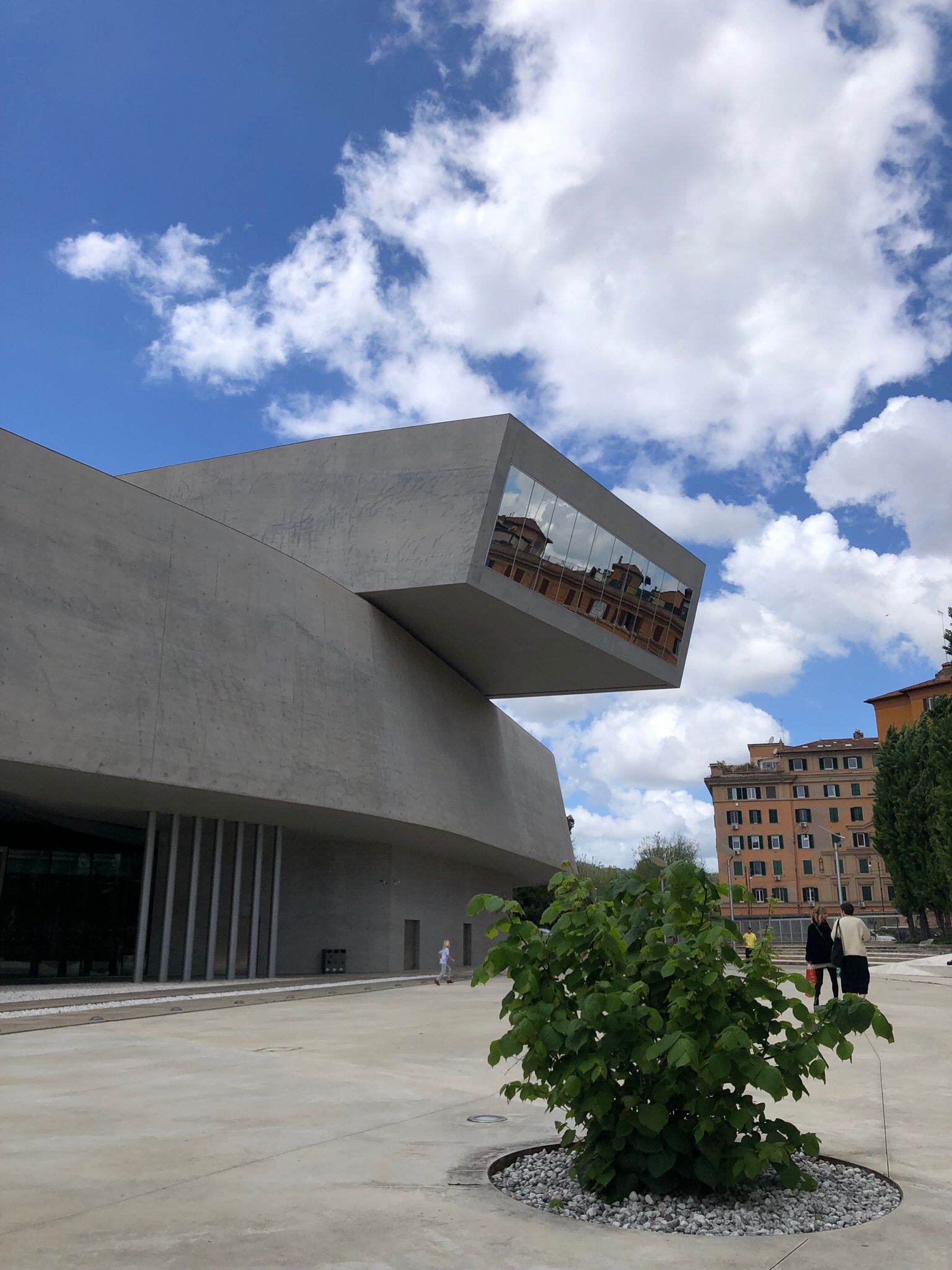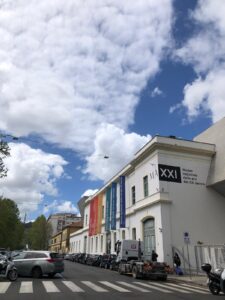 This past April, I visited the MAXXI Museum of the 21st Century Arts in Rome — a space celebrated worldwide as a bold, futuristic beacon designed by the late Zaha Hadid. Known for her sweeping, deconstructivist style, Hadid was a visionary. The MAXXI stands as one of her most prominent European creations — a sprawling network of intersecting volumes, curves, and stark surfaces. And yet, as I walked through it, I couldn’t help but feel profoundly disconnected.
This past April, I visited the MAXXI Museum of the 21st Century Arts in Rome — a space celebrated worldwide as a bold, futuristic beacon designed by the late Zaha Hadid. Known for her sweeping, deconstructivist style, Hadid was a visionary. The MAXXI stands as one of her most prominent European creations — a sprawling network of intersecting volumes, curves, and stark surfaces. And yet, as I walked through it, I couldn’t help but feel profoundly disconnected.
At first glance, the MAXXI impresses with scale and drama. It dominates the Flaminio district with its irregular shapes, tall concrete walls, and cold materials — mainly steel, reinforced cement, and glass. From the outside, it exudes power, almost verging on intimidation. It’s majestic, yes — but not magnificent. Its aesthetic strikes not awe, but rather a kind of respectful unease.
As I explored its winding paths and convoluted ceilings, I realized what was missing: warmth, emotion, grounding — the soulful architecture that createshealing environments.
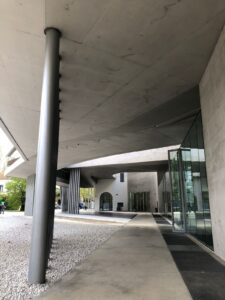
From the perspective of Anthro-Feng Shui and the anthropology of space, the MAXXI is heavily dominated by the Metal element — a symbol of rationality, authority, and austerity. The subdued greys and whites, the sharp forms, and the use of hard, reflective surfaces reflect this. Metal, while powerful and precise, lacks the emotional nourishment of the Earth element or the organic vitality of Wood and Water. Walking through MAXXI felt like navigating a world of abstract ideas without roots — more of a mental exercise than a soulful experience.
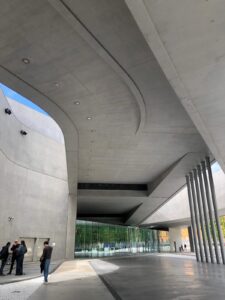
Even the designated “rest areas” felt transient. Tucked away under staircases in circulation zones, they seemed to discourage lingering. One doesn’t settle into the MAXXI; one passes through — or floats, untethered. It is a space designed more to impress than to embrace.
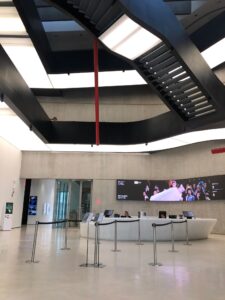
Hadid’s design may intentionally reflect the nature of contemporary art — conceptual, cerebral, and often emotionally detached. In this way, the building succeeds: it becomes an extension of the kind of art it houses. But in doing so, it loses touch with the principles of conscious design and human-centered space — principles that are foundational to creating environments where people feel held, seen, and inspired.
That said, there were two elements that stood out as meaningful gestures of connection.
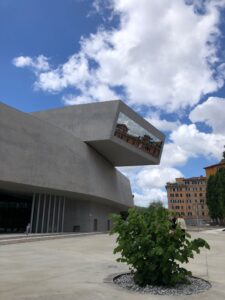
The first was the mirrored parallelepiped that protrudes from the main structure. This architectural element reflects the surrounding urban landscape, including the historic church across the museum and neighboring buildings. This is one of the few places where the building acknowledges and communicates with its context, creating a brief moment of dialogue between past and present, between the futuristic and the familiar. It’s a rare instance where the museum reaches out, rather than folding in on itself.
The second was the outdoor playground. In the late afternoon, families gathered there, and the space transformed. Despite the cold metal and concrete features and unfunctional benches, the white pebbled area became a lively arena of laughter and social connection. Children ran freely, their joy infusing the space with the very vitality it otherwise lacked. In this moment, the MAXXI fulfilled — however briefly — the role of a socially inclusive public space. It reminded me that people — not materials — bring warmth and soul to a place.
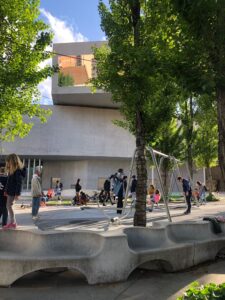
Still, from the standpoint of the anthropology of place, the MAXXI remains a space without emotional grounding. I had anticipated inspiration, a sense of being propelled into the future of artistic creativity. Instead, I was left feeling disoriented, disconnected from the cosmos, from creativity, and from the space itself. The museum seems more like a monument to the ego of the designer than a reflection of the wellbeing of those who use it.
This visit reaffirmed my belief in the necessity of holistic design — design that connects not only with the eye, but with the heart, body, and spirit. Public architecture should strive to be more than conceptually impressive; it should be emotionally resonant, spiritually grounding, and aesthetically nourishing. This is what creates healing environments and soulful architecture — places that people return to, not just because they’re important, but because they feel good to be in.
The MAXXI may dominate the skyline, but in the absence of emotional connection to place, it leaves us longing for something deeper — a reminder that true innovation in architecture must serve not only the future, but also the human soul.
What Kind of Spaces Speak to Your Soul?
Architecture shapes more than cities — it shapes how we feel, connect, and belong. As you reflect on this visit to the MAXXI, I invite you to consider:
🔹 What kind of public spaces leave you feeling inspired, safe, or grounded?
🔹 Do you believe architecture should move beyond aesthetics to truly support human wellbeing?
💬 I’d love to hear your reflections — feel free to leave a comment, or reach out directly if this sparked something in you. Let’s keep the conversation going about how we can design spaces that truly nourish the human spirit.
For more on Anthro-Feng Shui, holistic spatial design, or to explore how to bring these principles into your own environment, feel free to browse the site or get in touch.
Let’s imagine and create spaces that connect deeply — not just with the eye, but with the heart. 🌿

